Urban Planning & Design Report: Analysis of NSW's Better Placed Policy
VerifiedAdded on 2023/04/04
|13
|3070
|92
Report
AI Summary
This report provides a detailed analysis of the 'Better Placed' policy in New South Wales, examining its effectiveness in urban planning and design. It discusses the policy's role in shaping the built environment, promoting good design principles, and integrating various aspects of place-making, environmental stewardship, social equality, and economic viability. The report highlights how the NSW government uses the policy to manage urban transformation, support design excellence, and ensure that cities and towns are well-designed. It also explores how different stakeholders, including state and local governments, communities, architects, developers, planners, engineers, and builders, can utilize the 'Better Placed' policy to achieve better design outcomes and contribute to the creation of sustainable and livable places. The report emphasizes the importance of early integration, collaboration, and long-term decision-making in the design process, aligning with the goals of the 'Better Placed' policy to deliver the best possible results for New South Wales.
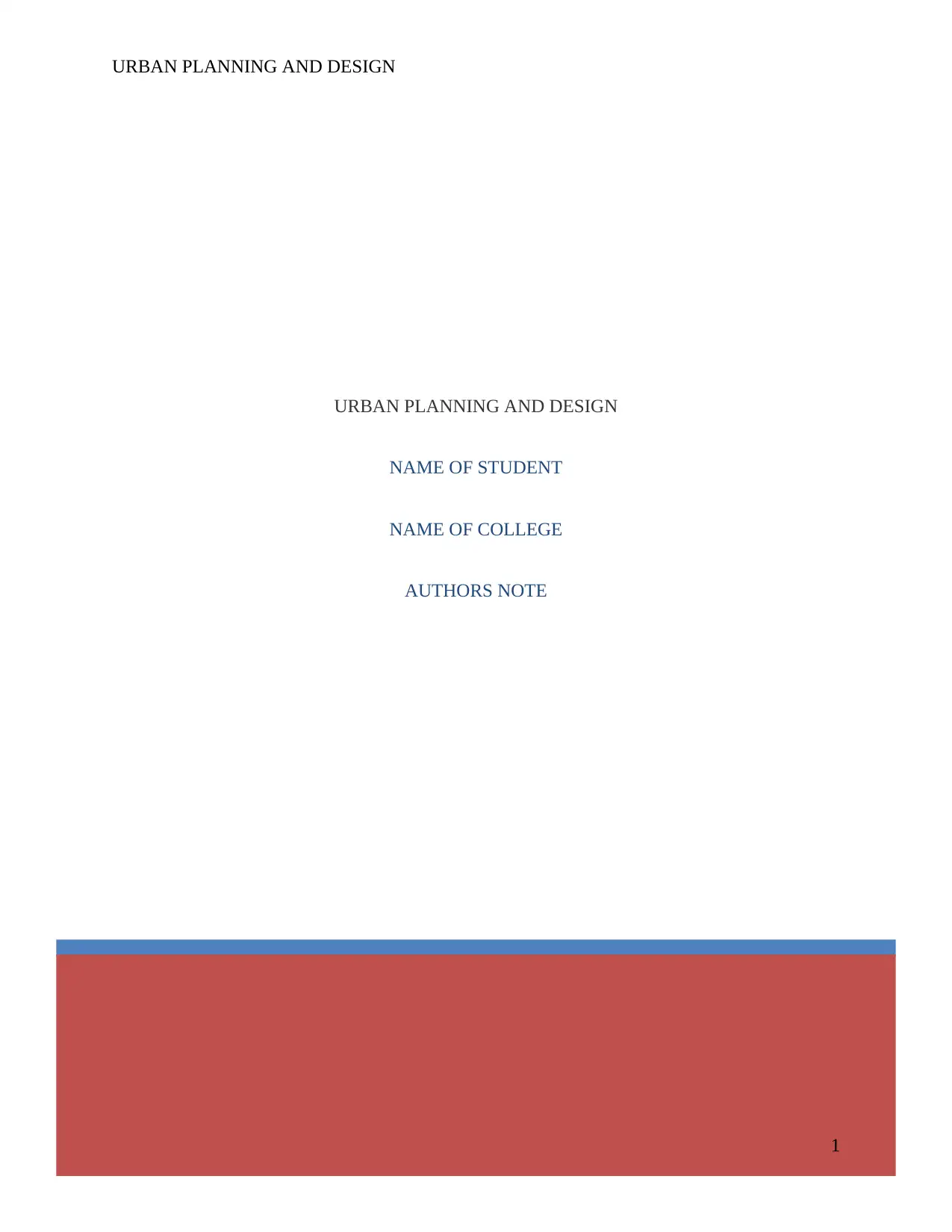
URBAN PLANNING AND DESIGN
NAME OF STUDENT
NAME OF COLLEGE
AUTHORS NOTE
URBAN PLANNING AND DESIGN
1
NAME OF STUDENT
NAME OF COLLEGE
AUTHORS NOTE
URBAN PLANNING AND DESIGN
1
Paraphrase This Document
Need a fresh take? Get an instant paraphrase of this document with our AI Paraphraser
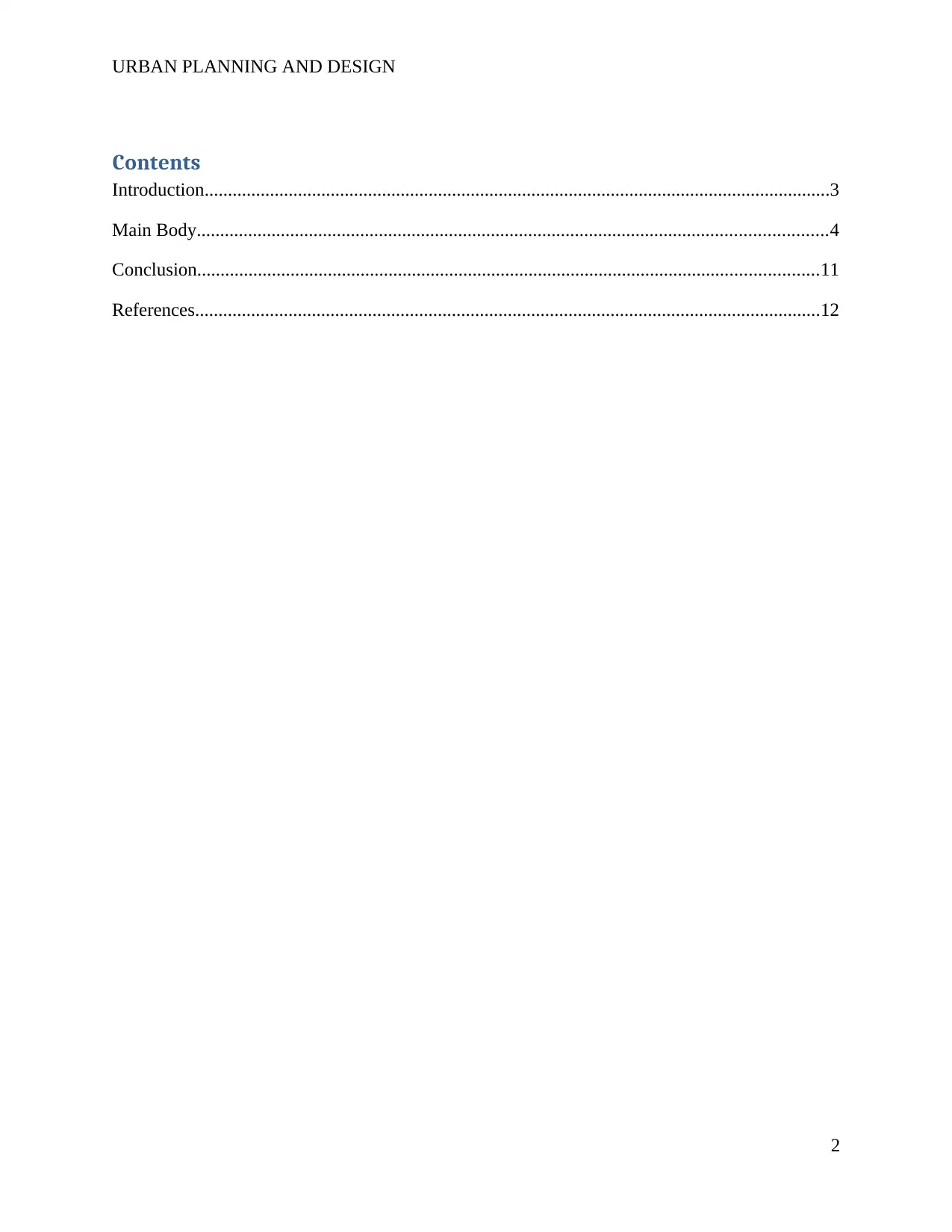
URBAN PLANNING AND DESIGN
Contents
Introduction......................................................................................................................................3
Main Body.......................................................................................................................................4
Conclusion.....................................................................................................................................11
References......................................................................................................................................12
2
Contents
Introduction......................................................................................................................................3
Main Body.......................................................................................................................................4
Conclusion.....................................................................................................................................11
References......................................................................................................................................12
2
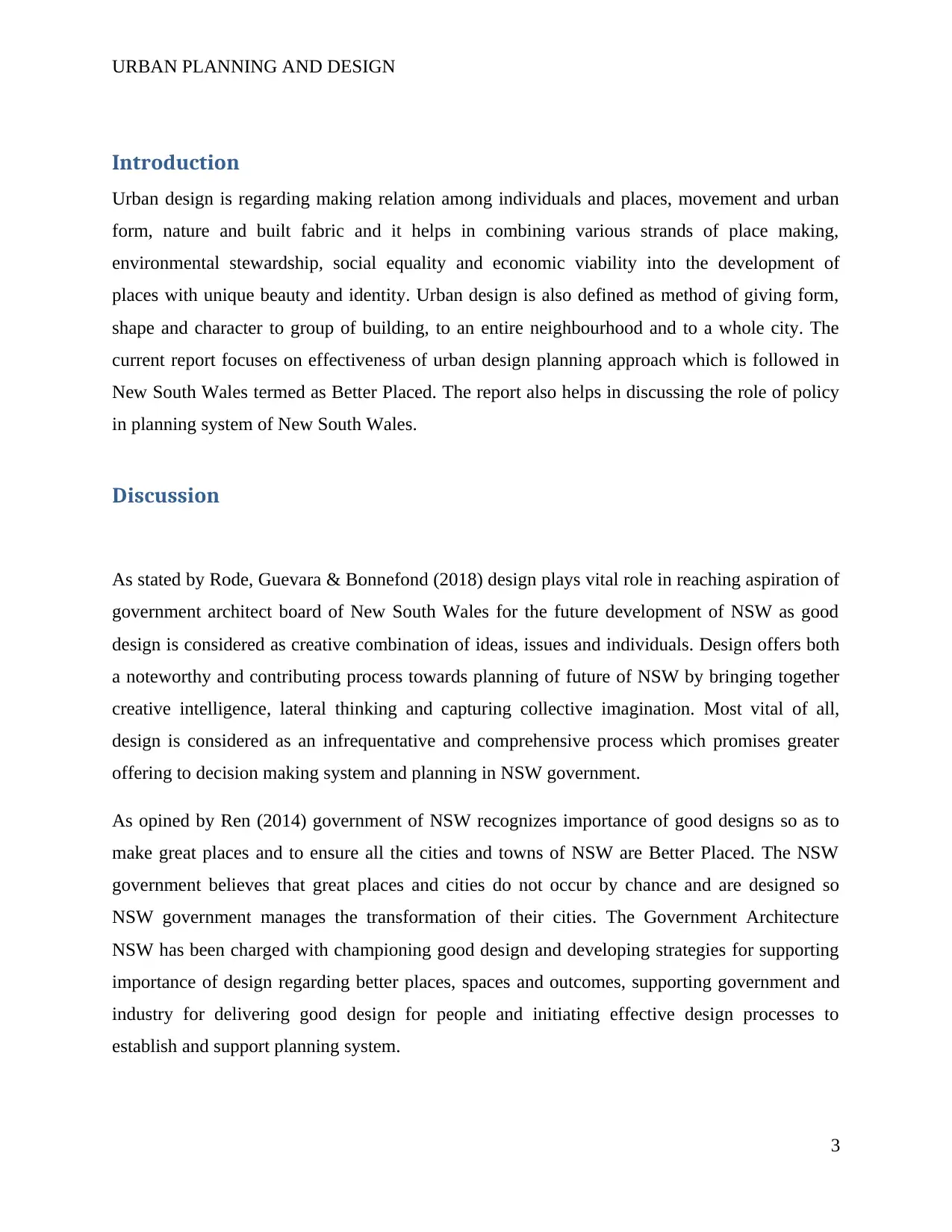
URBAN PLANNING AND DESIGN
Introduction
Urban design is regarding making relation among individuals and places, movement and urban
form, nature and built fabric and it helps in combining various strands of place making,
environmental stewardship, social equality and economic viability into the development of
places with unique beauty and identity. Urban design is also defined as method of giving form,
shape and character to group of building, to an entire neighbourhood and to a whole city. The
current report focuses on effectiveness of urban design planning approach which is followed in
New South Wales termed as Better Placed. The report also helps in discussing the role of policy
in planning system of New South Wales.
Discussion
As stated by Rode, Guevara & Bonnefond (2018) design plays vital role in reaching aspiration of
government architect board of New South Wales for the future development of NSW as good
design is considered as creative combination of ideas, issues and individuals. Design offers both
a noteworthy and contributing process towards planning of future of NSW by bringing together
creative intelligence, lateral thinking and capturing collective imagination. Most vital of all,
design is considered as an infrequentative and comprehensive process which promises greater
offering to decision making system and planning in NSW government.
As opined by Ren (2014) government of NSW recognizes importance of good designs so as to
make great places and to ensure all the cities and towns of NSW are Better Placed. The NSW
government believes that great places and cities do not occur by chance and are designed so
NSW government manages the transformation of their cities. The Government Architecture
NSW has been charged with championing good design and developing strategies for supporting
importance of design regarding better places, spaces and outcomes, supporting government and
industry for delivering good design for people and initiating effective design processes to
establish and support planning system.
3
Introduction
Urban design is regarding making relation among individuals and places, movement and urban
form, nature and built fabric and it helps in combining various strands of place making,
environmental stewardship, social equality and economic viability into the development of
places with unique beauty and identity. Urban design is also defined as method of giving form,
shape and character to group of building, to an entire neighbourhood and to a whole city. The
current report focuses on effectiveness of urban design planning approach which is followed in
New South Wales termed as Better Placed. The report also helps in discussing the role of policy
in planning system of New South Wales.
Discussion
As stated by Rode, Guevara & Bonnefond (2018) design plays vital role in reaching aspiration of
government architect board of New South Wales for the future development of NSW as good
design is considered as creative combination of ideas, issues and individuals. Design offers both
a noteworthy and contributing process towards planning of future of NSW by bringing together
creative intelligence, lateral thinking and capturing collective imagination. Most vital of all,
design is considered as an infrequentative and comprehensive process which promises greater
offering to decision making system and planning in NSW government.
As opined by Ren (2014) government of NSW recognizes importance of good designs so as to
make great places and to ensure all the cities and towns of NSW are Better Placed. The NSW
government believes that great places and cities do not occur by chance and are designed so
NSW government manages the transformation of their cities. The Government Architecture
NSW has been charged with championing good design and developing strategies for supporting
importance of design regarding better places, spaces and outcomes, supporting government and
industry for delivering good design for people and initiating effective design processes to
establish and support planning system.
3
⊘ This is a preview!⊘
Do you want full access?
Subscribe today to unlock all pages.

Trusted by 1+ million students worldwide
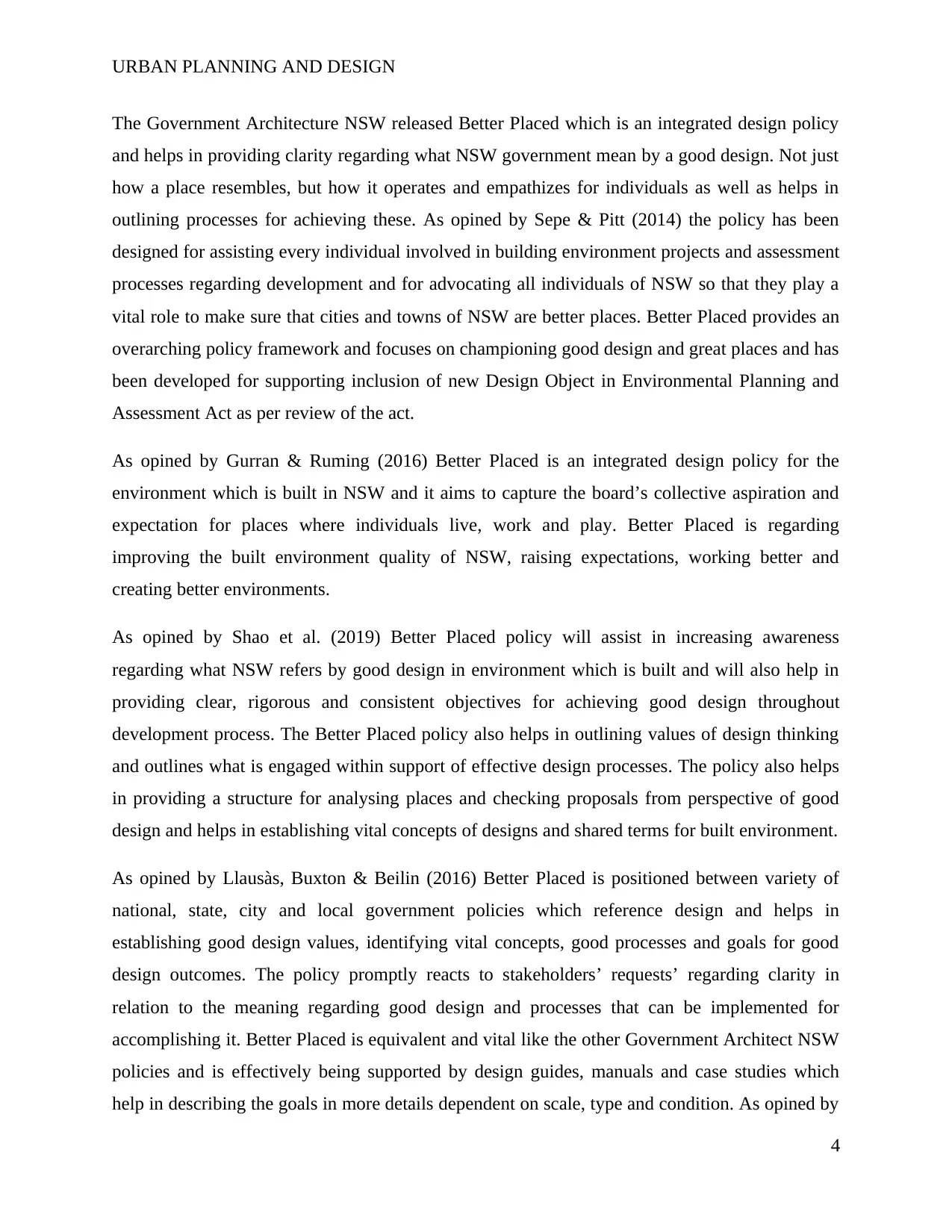
URBAN PLANNING AND DESIGN
The Government Architecture NSW released Better Placed which is an integrated design policy
and helps in providing clarity regarding what NSW government mean by a good design. Not just
how a place resembles, but how it operates and empathizes for individuals as well as helps in
outlining processes for achieving these. As opined by Sepe & Pitt (2014) the policy has been
designed for assisting every individual involved in building environment projects and assessment
processes regarding development and for advocating all individuals of NSW so that they play a
vital role to make sure that cities and towns of NSW are better places. Better Placed provides an
overarching policy framework and focuses on championing good design and great places and has
been developed for supporting inclusion of new Design Object in Environmental Planning and
Assessment Act as per review of the act.
As opined by Gurran & Ruming (2016) Better Placed is an integrated design policy for the
environment which is built in NSW and it aims to capture the board’s collective aspiration and
expectation for places where individuals live, work and play. Better Placed is regarding
improving the built environment quality of NSW, raising expectations, working better and
creating better environments.
As opined by Shao et al. (2019) Better Placed policy will assist in increasing awareness
regarding what NSW refers by good design in environment which is built and will also help in
providing clear, rigorous and consistent objectives for achieving good design throughout
development process. The Better Placed policy also helps in outlining values of design thinking
and outlines what is engaged within support of effective design processes. The policy also helps
in providing a structure for analysing places and checking proposals from perspective of good
design and helps in establishing vital concepts of designs and shared terms for built environment.
As opined by Llausàs, Buxton & Beilin (2016) Better Placed is positioned between variety of
national, state, city and local government policies which reference design and helps in
establishing good design values, identifying vital concepts, good processes and goals for good
design outcomes. The policy promptly reacts to stakeholders’ requests’ regarding clarity in
relation to the meaning regarding good design and processes that can be implemented for
accomplishing it. Better Placed is equivalent and vital like the other Government Architect NSW
policies and is effectively being supported by design guides, manuals and case studies which
help in describing the goals in more details dependent on scale, type and condition. As opined by
4
The Government Architecture NSW released Better Placed which is an integrated design policy
and helps in providing clarity regarding what NSW government mean by a good design. Not just
how a place resembles, but how it operates and empathizes for individuals as well as helps in
outlining processes for achieving these. As opined by Sepe & Pitt (2014) the policy has been
designed for assisting every individual involved in building environment projects and assessment
processes regarding development and for advocating all individuals of NSW so that they play a
vital role to make sure that cities and towns of NSW are better places. Better Placed provides an
overarching policy framework and focuses on championing good design and great places and has
been developed for supporting inclusion of new Design Object in Environmental Planning and
Assessment Act as per review of the act.
As opined by Gurran & Ruming (2016) Better Placed is an integrated design policy for the
environment which is built in NSW and it aims to capture the board’s collective aspiration and
expectation for places where individuals live, work and play. Better Placed is regarding
improving the built environment quality of NSW, raising expectations, working better and
creating better environments.
As opined by Shao et al. (2019) Better Placed policy will assist in increasing awareness
regarding what NSW refers by good design in environment which is built and will also help in
providing clear, rigorous and consistent objectives for achieving good design throughout
development process. The Better Placed policy also helps in outlining values of design thinking
and outlines what is engaged within support of effective design processes. The policy also helps
in providing a structure for analysing places and checking proposals from perspective of good
design and helps in establishing vital concepts of designs and shared terms for built environment.
As opined by Llausàs, Buxton & Beilin (2016) Better Placed is positioned between variety of
national, state, city and local government policies which reference design and helps in
establishing good design values, identifying vital concepts, good processes and goals for good
design outcomes. The policy promptly reacts to stakeholders’ requests’ regarding clarity in
relation to the meaning regarding good design and processes that can be implemented for
accomplishing it. Better Placed is equivalent and vital like the other Government Architect NSW
policies and is effectively being supported by design guides, manuals and case studies which
help in describing the goals in more details dependent on scale, type and condition. As opined by
4
Paraphrase This Document
Need a fresh take? Get an instant paraphrase of this document with our AI Paraphraser
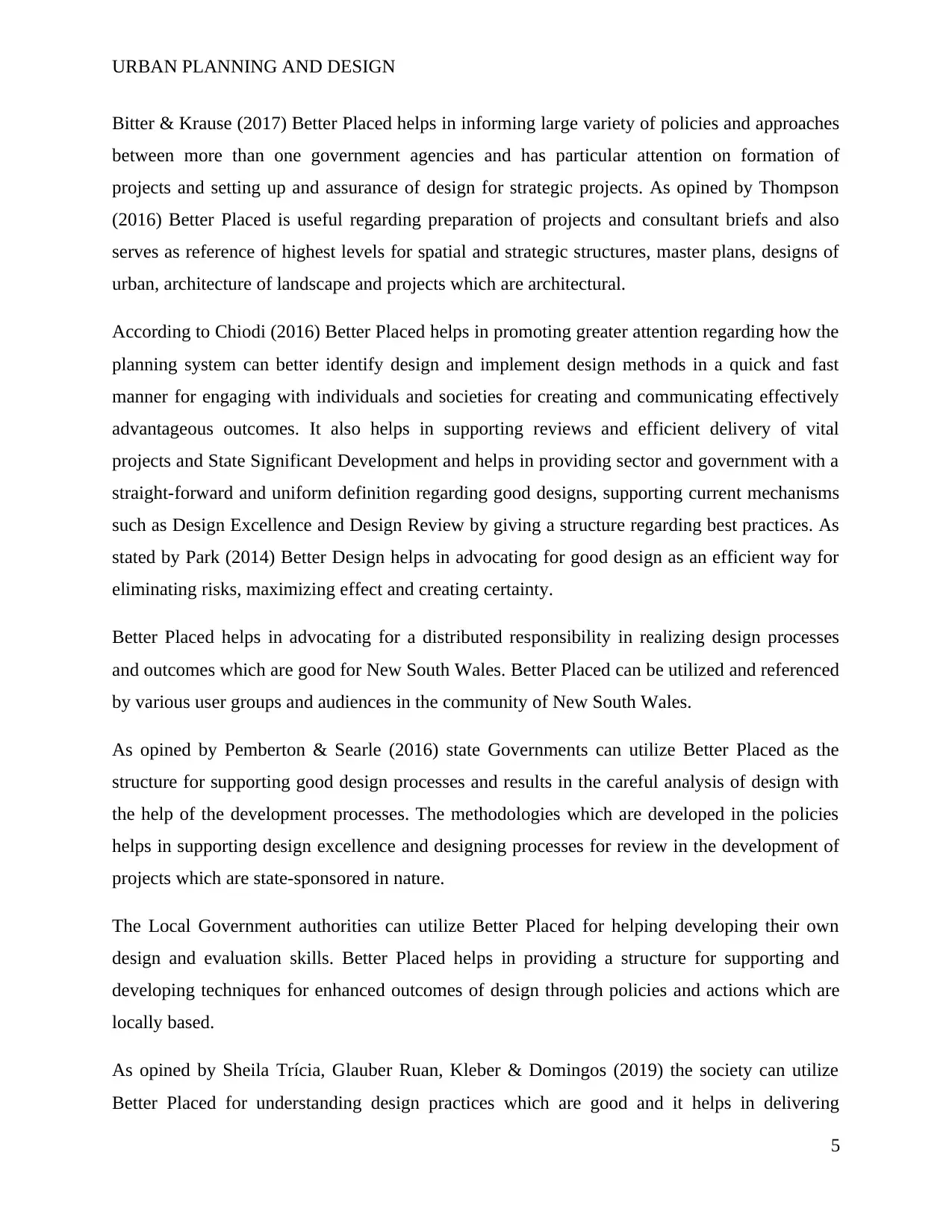
URBAN PLANNING AND DESIGN
Bitter & Krause (2017) Better Placed helps in informing large variety of policies and approaches
between more than one government agencies and has particular attention on formation of
projects and setting up and assurance of design for strategic projects. As opined by Thompson
(2016) Better Placed is useful regarding preparation of projects and consultant briefs and also
serves as reference of highest levels for spatial and strategic structures, master plans, designs of
urban, architecture of landscape and projects which are architectural.
According to Chiodi (2016) Better Placed helps in promoting greater attention regarding how the
planning system can better identify design and implement design methods in a quick and fast
manner for engaging with individuals and societies for creating and communicating effectively
advantageous outcomes. It also helps in supporting reviews and efficient delivery of vital
projects and State Significant Development and helps in providing sector and government with a
straight-forward and uniform definition regarding good designs, supporting current mechanisms
such as Design Excellence and Design Review by giving a structure regarding best practices. As
stated by Park (2014) Better Design helps in advocating for good design as an efficient way for
eliminating risks, maximizing effect and creating certainty.
Better Placed helps in advocating for a distributed responsibility in realizing design processes
and outcomes which are good for New South Wales. Better Placed can be utilized and referenced
by various user groups and audiences in the community of New South Wales.
As opined by Pemberton & Searle (2016) state Governments can utilize Better Placed as the
structure for supporting good design processes and results in the careful analysis of design with
the help of the development processes. The methodologies which are developed in the policies
helps in supporting design excellence and designing processes for review in the development of
projects which are state-sponsored in nature.
The Local Government authorities can utilize Better Placed for helping developing their own
design and evaluation skills. Better Placed helps in providing a structure for supporting and
developing techniques for enhanced outcomes of design through policies and actions which are
locally based.
As opined by Sheila Trícia, Glauber Ruan, Kleber & Domingos (2019) the society can utilize
Better Placed for understanding design practices which are good and it helps in delivering
5
Bitter & Krause (2017) Better Placed helps in informing large variety of policies and approaches
between more than one government agencies and has particular attention on formation of
projects and setting up and assurance of design for strategic projects. As opined by Thompson
(2016) Better Placed is useful regarding preparation of projects and consultant briefs and also
serves as reference of highest levels for spatial and strategic structures, master plans, designs of
urban, architecture of landscape and projects which are architectural.
According to Chiodi (2016) Better Placed helps in promoting greater attention regarding how the
planning system can better identify design and implement design methods in a quick and fast
manner for engaging with individuals and societies for creating and communicating effectively
advantageous outcomes. It also helps in supporting reviews and efficient delivery of vital
projects and State Significant Development and helps in providing sector and government with a
straight-forward and uniform definition regarding good designs, supporting current mechanisms
such as Design Excellence and Design Review by giving a structure regarding best practices. As
stated by Park (2014) Better Design helps in advocating for good design as an efficient way for
eliminating risks, maximizing effect and creating certainty.
Better Placed helps in advocating for a distributed responsibility in realizing design processes
and outcomes which are good for New South Wales. Better Placed can be utilized and referenced
by various user groups and audiences in the community of New South Wales.
As opined by Pemberton & Searle (2016) state Governments can utilize Better Placed as the
structure for supporting good design processes and results in the careful analysis of design with
the help of the development processes. The methodologies which are developed in the policies
helps in supporting design excellence and designing processes for review in the development of
projects which are state-sponsored in nature.
The Local Government authorities can utilize Better Placed for helping developing their own
design and evaluation skills. Better Placed helps in providing a structure for supporting and
developing techniques for enhanced outcomes of design through policies and actions which are
locally based.
As opined by Sheila Trícia, Glauber Ruan, Kleber & Domingos (2019) the society can utilize
Better Placed for understanding design practices which are good and it helps in delivering
5
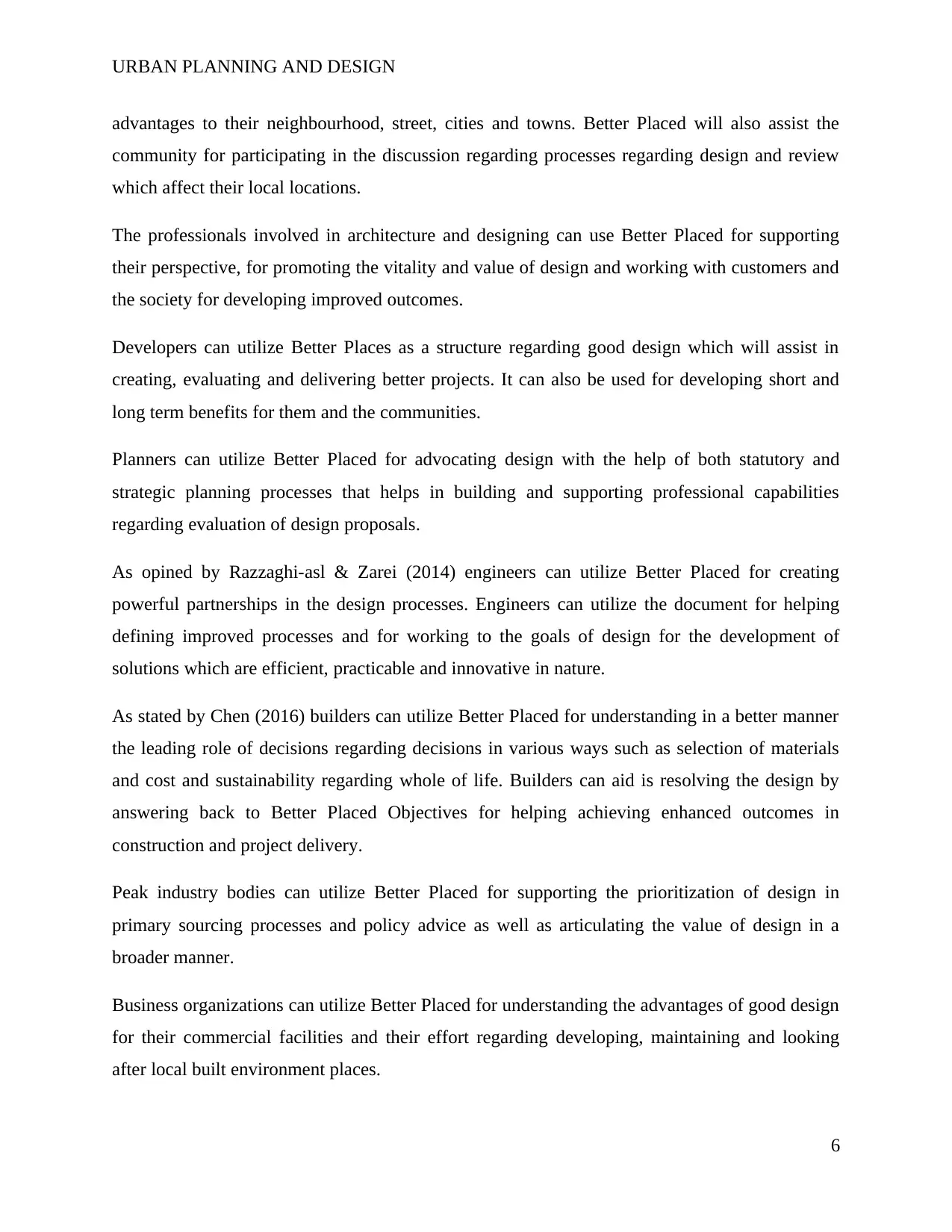
URBAN PLANNING AND DESIGN
advantages to their neighbourhood, street, cities and towns. Better Placed will also assist the
community for participating in the discussion regarding processes regarding design and review
which affect their local locations.
The professionals involved in architecture and designing can use Better Placed for supporting
their perspective, for promoting the vitality and value of design and working with customers and
the society for developing improved outcomes.
Developers can utilize Better Places as a structure regarding good design which will assist in
creating, evaluating and delivering better projects. It can also be used for developing short and
long term benefits for them and the communities.
Planners can utilize Better Placed for advocating design with the help of both statutory and
strategic planning processes that helps in building and supporting professional capabilities
regarding evaluation of design proposals.
As opined by Razzaghi-asl & Zarei (2014) engineers can utilize Better Placed for creating
powerful partnerships in the design processes. Engineers can utilize the document for helping
defining improved processes and for working to the goals of design for the development of
solutions which are efficient, practicable and innovative in nature.
As stated by Chen (2016) builders can utilize Better Placed for understanding in a better manner
the leading role of decisions regarding decisions in various ways such as selection of materials
and cost and sustainability regarding whole of life. Builders can aid is resolving the design by
answering back to Better Placed Objectives for helping achieving enhanced outcomes in
construction and project delivery.
Peak industry bodies can utilize Better Placed for supporting the prioritization of design in
primary sourcing processes and policy advice as well as articulating the value of design in a
broader manner.
Business organizations can utilize Better Placed for understanding the advantages of good design
for their commercial facilities and their effort regarding developing, maintaining and looking
after local built environment places.
6
advantages to their neighbourhood, street, cities and towns. Better Placed will also assist the
community for participating in the discussion regarding processes regarding design and review
which affect their local locations.
The professionals involved in architecture and designing can use Better Placed for supporting
their perspective, for promoting the vitality and value of design and working with customers and
the society for developing improved outcomes.
Developers can utilize Better Places as a structure regarding good design which will assist in
creating, evaluating and delivering better projects. It can also be used for developing short and
long term benefits for them and the communities.
Planners can utilize Better Placed for advocating design with the help of both statutory and
strategic planning processes that helps in building and supporting professional capabilities
regarding evaluation of design proposals.
As opined by Razzaghi-asl & Zarei (2014) engineers can utilize Better Placed for creating
powerful partnerships in the design processes. Engineers can utilize the document for helping
defining improved processes and for working to the goals of design for the development of
solutions which are efficient, practicable and innovative in nature.
As stated by Chen (2016) builders can utilize Better Placed for understanding in a better manner
the leading role of decisions regarding decisions in various ways such as selection of materials
and cost and sustainability regarding whole of life. Builders can aid is resolving the design by
answering back to Better Placed Objectives for helping achieving enhanced outcomes in
construction and project delivery.
Peak industry bodies can utilize Better Placed for supporting the prioritization of design in
primary sourcing processes and policy advice as well as articulating the value of design in a
broader manner.
Business organizations can utilize Better Placed for understanding the advantages of good design
for their commercial facilities and their effort regarding developing, maintaining and looking
after local built environment places.
6
⊘ This is a preview!⊘
Do you want full access?
Subscribe today to unlock all pages.

Trusted by 1+ million students worldwide
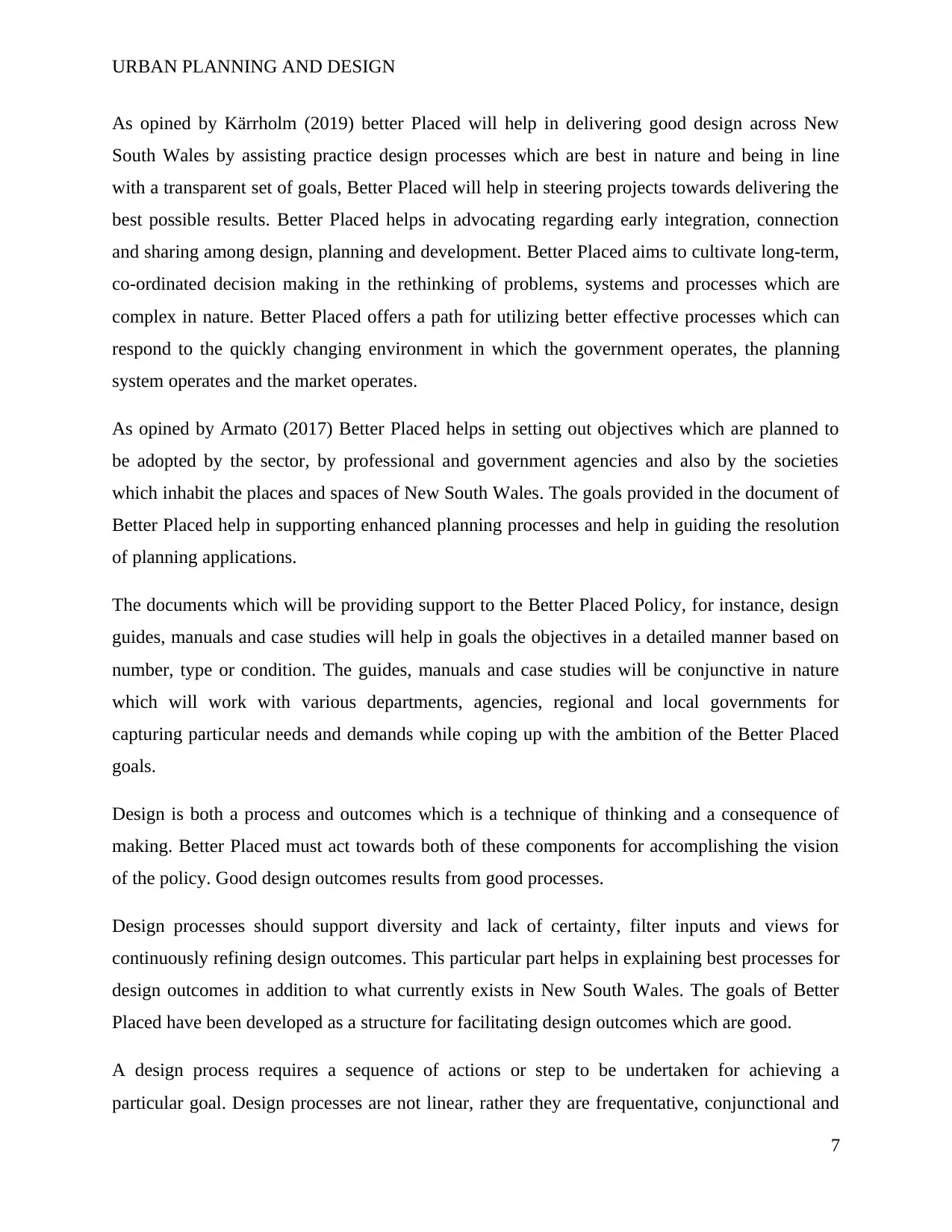
URBAN PLANNING AND DESIGN
As opined by Kärrholm (2019) better Placed will help in delivering good design across New
South Wales by assisting practice design processes which are best in nature and being in line
with a transparent set of goals, Better Placed will help in steering projects towards delivering the
best possible results. Better Placed helps in advocating regarding early integration, connection
and sharing among design, planning and development. Better Placed aims to cultivate long-term,
co-ordinated decision making in the rethinking of problems, systems and processes which are
complex in nature. Better Placed offers a path for utilizing better effective processes which can
respond to the quickly changing environment in which the government operates, the planning
system operates and the market operates.
As opined by Armato (2017) Better Placed helps in setting out objectives which are planned to
be adopted by the sector, by professional and government agencies and also by the societies
which inhabit the places and spaces of New South Wales. The goals provided in the document of
Better Placed help in supporting enhanced planning processes and help in guiding the resolution
of planning applications.
The documents which will be providing support to the Better Placed Policy, for instance, design
guides, manuals and case studies will help in goals the objectives in a detailed manner based on
number, type or condition. The guides, manuals and case studies will be conjunctive in nature
which will work with various departments, agencies, regional and local governments for
capturing particular needs and demands while coping up with the ambition of the Better Placed
goals.
Design is both a process and outcomes which is a technique of thinking and a consequence of
making. Better Placed must act towards both of these components for accomplishing the vision
of the policy. Good design outcomes results from good processes.
Design processes should support diversity and lack of certainty, filter inputs and views for
continuously refining design outcomes. This particular part helps in explaining best processes for
design outcomes in addition to what currently exists in New South Wales. The goals of Better
Placed have been developed as a structure for facilitating design outcomes which are good.
A design process requires a sequence of actions or step to be undertaken for achieving a
particular goal. Design processes are not linear, rather they are frequentative, conjunctional and
7
As opined by Kärrholm (2019) better Placed will help in delivering good design across New
South Wales by assisting practice design processes which are best in nature and being in line
with a transparent set of goals, Better Placed will help in steering projects towards delivering the
best possible results. Better Placed helps in advocating regarding early integration, connection
and sharing among design, planning and development. Better Placed aims to cultivate long-term,
co-ordinated decision making in the rethinking of problems, systems and processes which are
complex in nature. Better Placed offers a path for utilizing better effective processes which can
respond to the quickly changing environment in which the government operates, the planning
system operates and the market operates.
As opined by Armato (2017) Better Placed helps in setting out objectives which are planned to
be adopted by the sector, by professional and government agencies and also by the societies
which inhabit the places and spaces of New South Wales. The goals provided in the document of
Better Placed help in supporting enhanced planning processes and help in guiding the resolution
of planning applications.
The documents which will be providing support to the Better Placed Policy, for instance, design
guides, manuals and case studies will help in goals the objectives in a detailed manner based on
number, type or condition. The guides, manuals and case studies will be conjunctive in nature
which will work with various departments, agencies, regional and local governments for
capturing particular needs and demands while coping up with the ambition of the Better Placed
goals.
Design is both a process and outcomes which is a technique of thinking and a consequence of
making. Better Placed must act towards both of these components for accomplishing the vision
of the policy. Good design outcomes results from good processes.
Design processes should support diversity and lack of certainty, filter inputs and views for
continuously refining design outcomes. This particular part helps in explaining best processes for
design outcomes in addition to what currently exists in New South Wales. The goals of Better
Placed have been developed as a structure for facilitating design outcomes which are good.
A design process requires a sequence of actions or step to be undertaken for achieving a
particular goal. Design processes are not linear, rather they are frequentative, conjunctional and
7
Paraphrase This Document
Need a fresh take? Get an instant paraphrase of this document with our AI Paraphraser
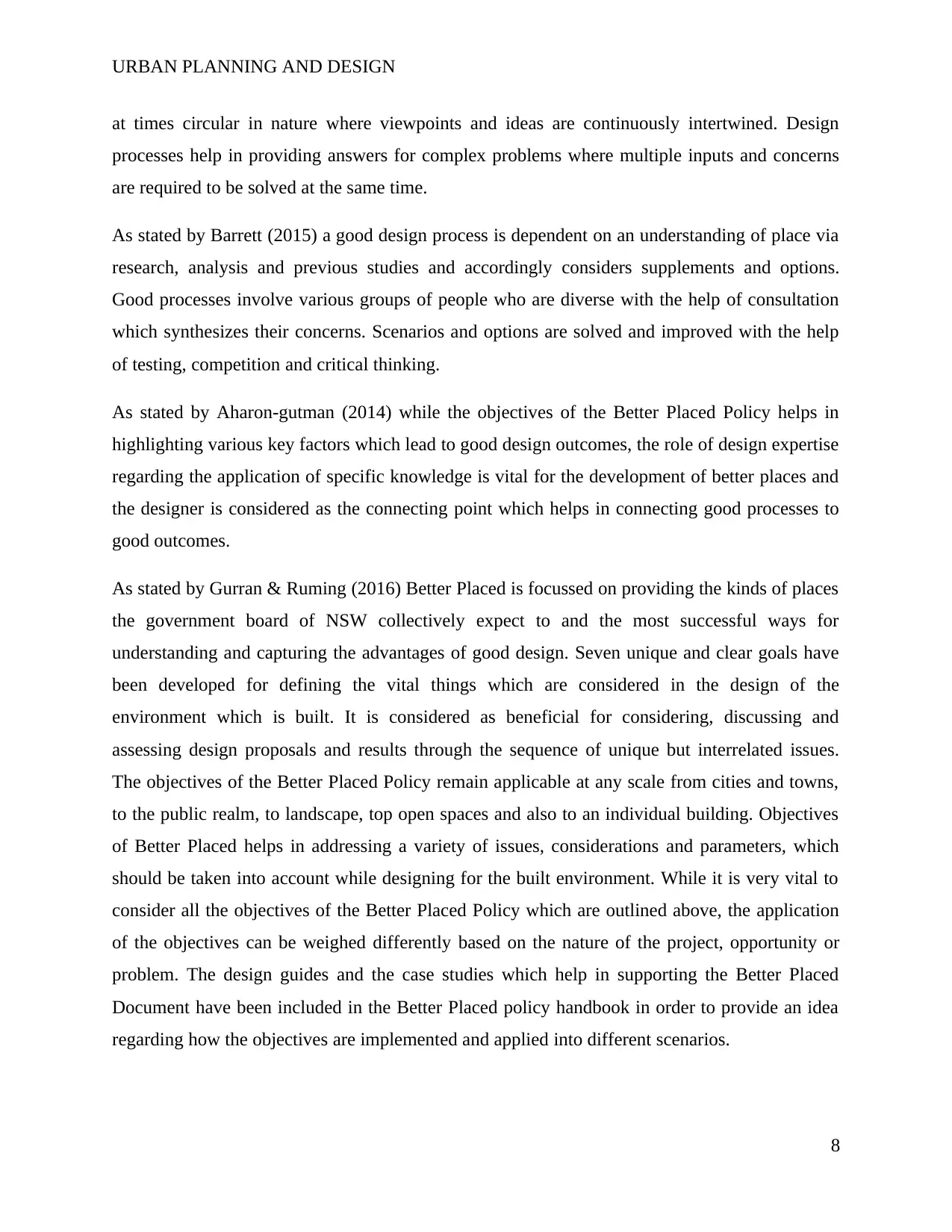
URBAN PLANNING AND DESIGN
at times circular in nature where viewpoints and ideas are continuously intertwined. Design
processes help in providing answers for complex problems where multiple inputs and concerns
are required to be solved at the same time.
As stated by Barrett (2015) a good design process is dependent on an understanding of place via
research, analysis and previous studies and accordingly considers supplements and options.
Good processes involve various groups of people who are diverse with the help of consultation
which synthesizes their concerns. Scenarios and options are solved and improved with the help
of testing, competition and critical thinking.
As stated by Aharon-gutman (2014) while the objectives of the Better Placed Policy helps in
highlighting various key factors which lead to good design outcomes, the role of design expertise
regarding the application of specific knowledge is vital for the development of better places and
the designer is considered as the connecting point which helps in connecting good processes to
good outcomes.
As stated by Gurran & Ruming (2016) Better Placed is focussed on providing the kinds of places
the government board of NSW collectively expect to and the most successful ways for
understanding and capturing the advantages of good design. Seven unique and clear goals have
been developed for defining the vital things which are considered in the design of the
environment which is built. It is considered as beneficial for considering, discussing and
assessing design proposals and results through the sequence of unique but interrelated issues.
The objectives of the Better Placed Policy remain applicable at any scale from cities and towns,
to the public realm, to landscape, top open spaces and also to an individual building. Objectives
of Better Placed helps in addressing a variety of issues, considerations and parameters, which
should be taken into account while designing for the built environment. While it is very vital to
consider all the objectives of the Better Placed Policy which are outlined above, the application
of the objectives can be weighed differently based on the nature of the project, opportunity or
problem. The design guides and the case studies which help in supporting the Better Placed
Document have been included in the Better Placed policy handbook in order to provide an idea
regarding how the objectives are implemented and applied into different scenarios.
8
at times circular in nature where viewpoints and ideas are continuously intertwined. Design
processes help in providing answers for complex problems where multiple inputs and concerns
are required to be solved at the same time.
As stated by Barrett (2015) a good design process is dependent on an understanding of place via
research, analysis and previous studies and accordingly considers supplements and options.
Good processes involve various groups of people who are diverse with the help of consultation
which synthesizes their concerns. Scenarios and options are solved and improved with the help
of testing, competition and critical thinking.
As stated by Aharon-gutman (2014) while the objectives of the Better Placed Policy helps in
highlighting various key factors which lead to good design outcomes, the role of design expertise
regarding the application of specific knowledge is vital for the development of better places and
the designer is considered as the connecting point which helps in connecting good processes to
good outcomes.
As stated by Gurran & Ruming (2016) Better Placed is focussed on providing the kinds of places
the government board of NSW collectively expect to and the most successful ways for
understanding and capturing the advantages of good design. Seven unique and clear goals have
been developed for defining the vital things which are considered in the design of the
environment which is built. It is considered as beneficial for considering, discussing and
assessing design proposals and results through the sequence of unique but interrelated issues.
The objectives of the Better Placed Policy remain applicable at any scale from cities and towns,
to the public realm, to landscape, top open spaces and also to an individual building. Objectives
of Better Placed helps in addressing a variety of issues, considerations and parameters, which
should be taken into account while designing for the built environment. While it is very vital to
consider all the objectives of the Better Placed Policy which are outlined above, the application
of the objectives can be weighed differently based on the nature of the project, opportunity or
problem. The design guides and the case studies which help in supporting the Better Placed
Document have been included in the Better Placed policy handbook in order to provide an idea
regarding how the objectives are implemented and applied into different scenarios.
8
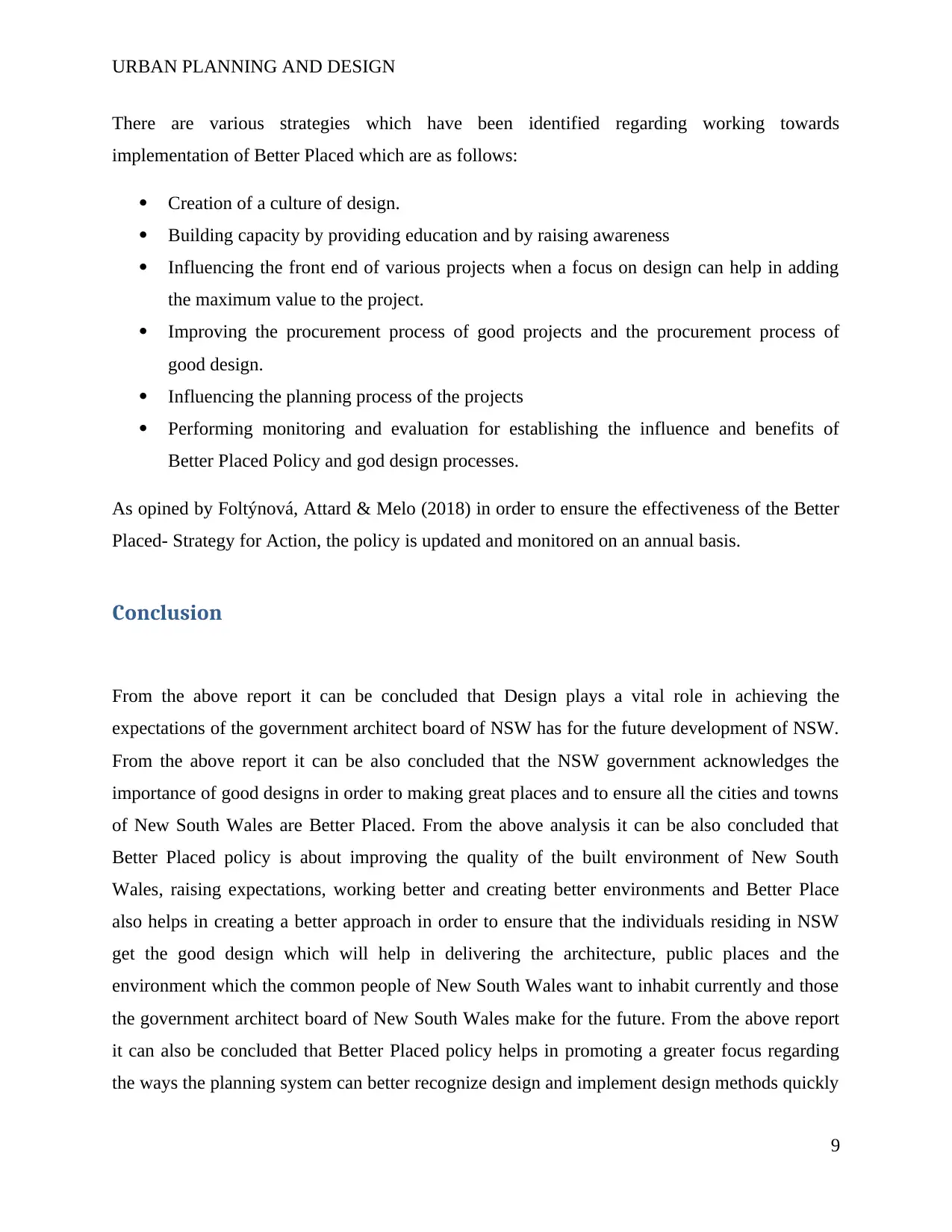
URBAN PLANNING AND DESIGN
There are various strategies which have been identified regarding working towards
implementation of Better Placed which are as follows:
Creation of a culture of design.
Building capacity by providing education and by raising awareness
Influencing the front end of various projects when a focus on design can help in adding
the maximum value to the project.
Improving the procurement process of good projects and the procurement process of
good design.
Influencing the planning process of the projects
Performing monitoring and evaluation for establishing the influence and benefits of
Better Placed Policy and god design processes.
As opined by Foltýnová, Attard & Melo (2018) in order to ensure the effectiveness of the Better
Placed- Strategy for Action, the policy is updated and monitored on an annual basis.
Conclusion
From the above report it can be concluded that Design plays a vital role in achieving the
expectations of the government architect board of NSW has for the future development of NSW.
From the above report it can be also concluded that the NSW government acknowledges the
importance of good designs in order to making great places and to ensure all the cities and towns
of New South Wales are Better Placed. From the above analysis it can be also concluded that
Better Placed policy is about improving the quality of the built environment of New South
Wales, raising expectations, working better and creating better environments and Better Place
also helps in creating a better approach in order to ensure that the individuals residing in NSW
get the good design which will help in delivering the architecture, public places and the
environment which the common people of New South Wales want to inhabit currently and those
the government architect board of New South Wales make for the future. From the above report
it can also be concluded that Better Placed policy helps in promoting a greater focus regarding
the ways the planning system can better recognize design and implement design methods quickly
9
There are various strategies which have been identified regarding working towards
implementation of Better Placed which are as follows:
Creation of a culture of design.
Building capacity by providing education and by raising awareness
Influencing the front end of various projects when a focus on design can help in adding
the maximum value to the project.
Improving the procurement process of good projects and the procurement process of
good design.
Influencing the planning process of the projects
Performing monitoring and evaluation for establishing the influence and benefits of
Better Placed Policy and god design processes.
As opined by Foltýnová, Attard & Melo (2018) in order to ensure the effectiveness of the Better
Placed- Strategy for Action, the policy is updated and monitored on an annual basis.
Conclusion
From the above report it can be concluded that Design plays a vital role in achieving the
expectations of the government architect board of NSW has for the future development of NSW.
From the above report it can be also concluded that the NSW government acknowledges the
importance of good designs in order to making great places and to ensure all the cities and towns
of New South Wales are Better Placed. From the above analysis it can be also concluded that
Better Placed policy is about improving the quality of the built environment of New South
Wales, raising expectations, working better and creating better environments and Better Place
also helps in creating a better approach in order to ensure that the individuals residing in NSW
get the good design which will help in delivering the architecture, public places and the
environment which the common people of New South Wales want to inhabit currently and those
the government architect board of New South Wales make for the future. From the above report
it can also be concluded that Better Placed policy helps in promoting a greater focus regarding
the ways the planning system can better recognize design and implement design methods quickly
9
⊘ This is a preview!⊘
Do you want full access?
Subscribe today to unlock all pages.

Trusted by 1+ million students worldwide
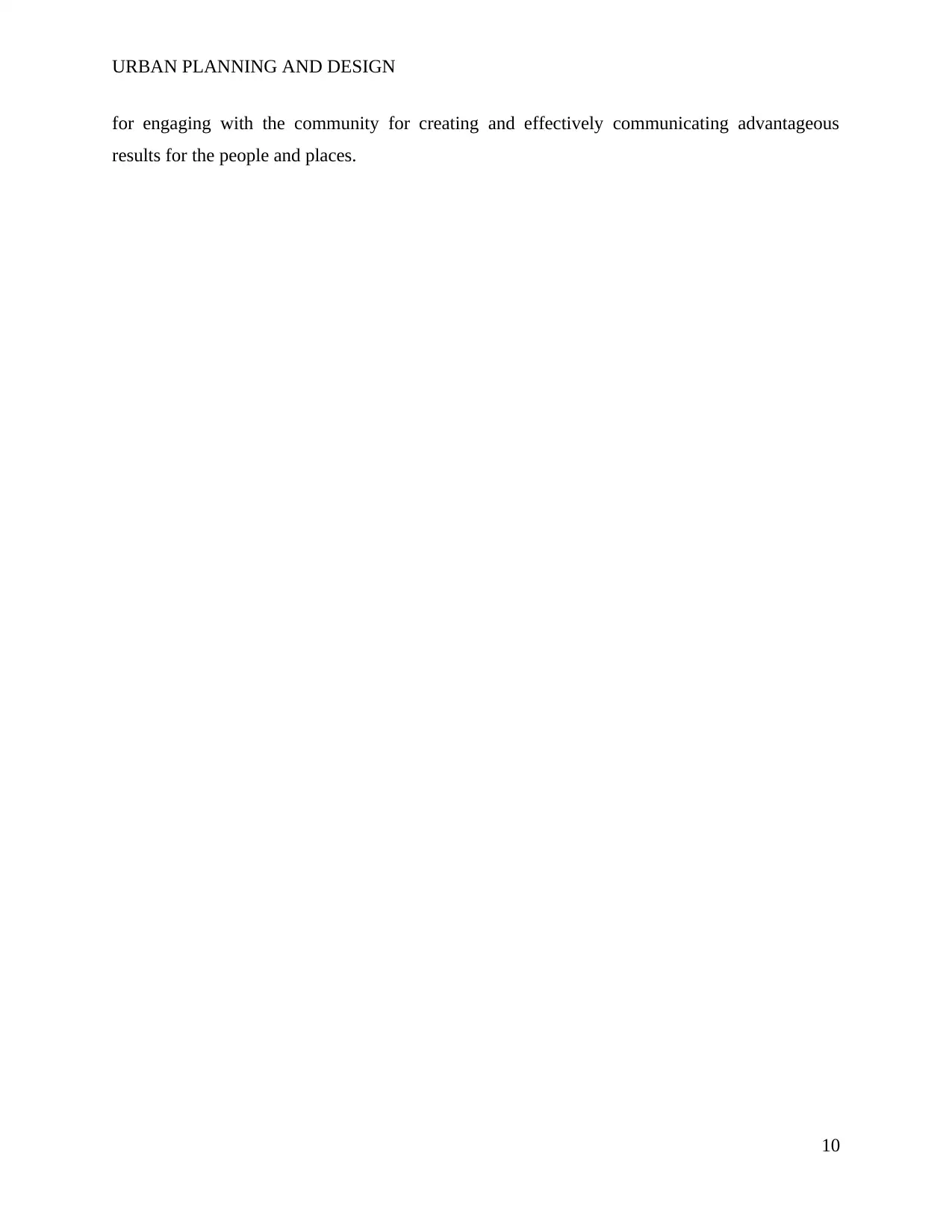
URBAN PLANNING AND DESIGN
for engaging with the community for creating and effectively communicating advantageous
results for the people and places.
10
for engaging with the community for creating and effectively communicating advantageous
results for the people and places.
10
Paraphrase This Document
Need a fresh take? Get an instant paraphrase of this document with our AI Paraphraser
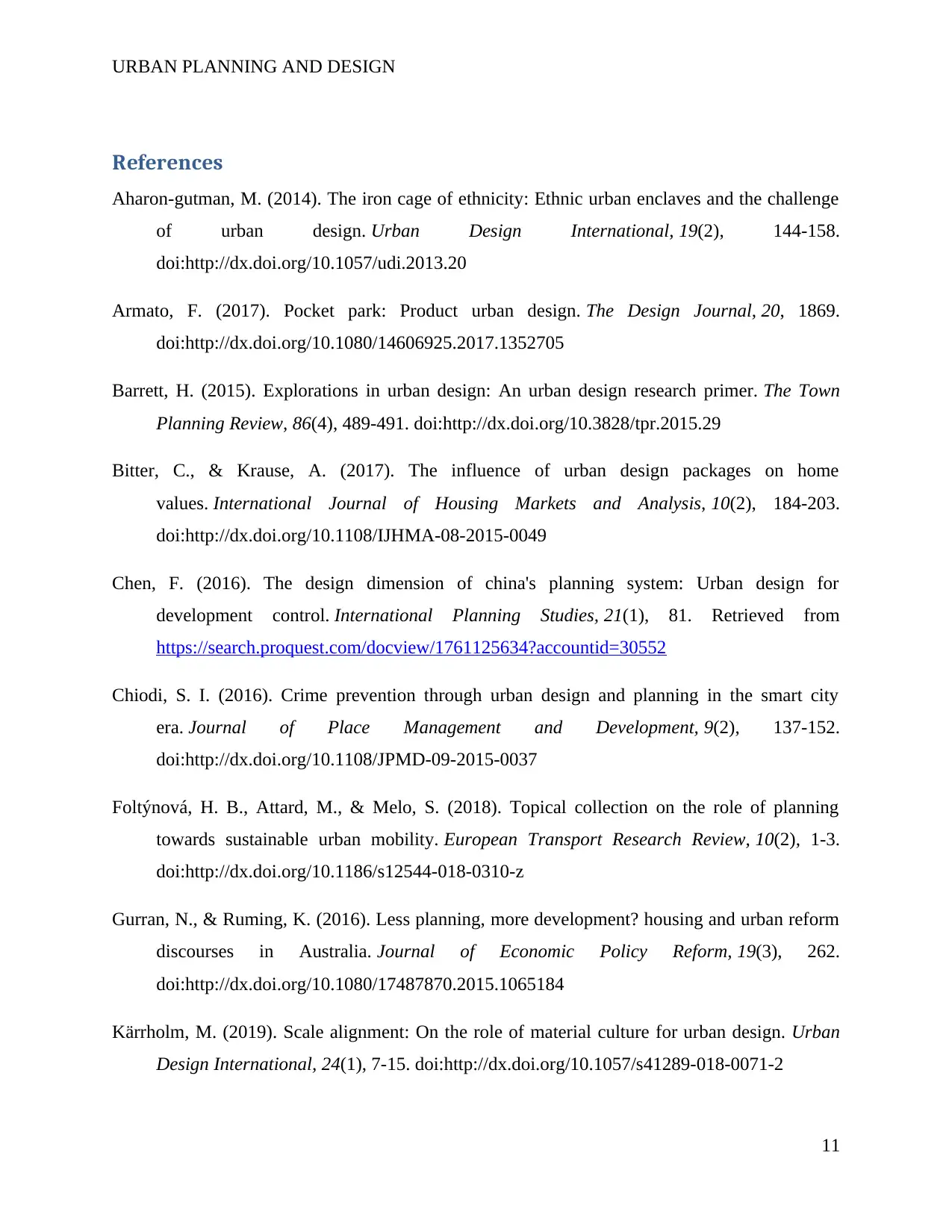
URBAN PLANNING AND DESIGN
References
Aharon-gutman, M. (2014). The iron cage of ethnicity: Ethnic urban enclaves and the challenge
of urban design. Urban Design International, 19(2), 144-158.
doi:http://dx.doi.org/10.1057/udi.2013.20
Armato, F. (2017). Pocket park: Product urban design. The Design Journal, 20, 1869.
doi:http://dx.doi.org/10.1080/14606925.2017.1352705
Barrett, H. (2015). Explorations in urban design: An urban design research primer. The Town
Planning Review, 86(4), 489-491. doi:http://dx.doi.org/10.3828/tpr.2015.29
Bitter, C., & Krause, A. (2017). The influence of urban design packages on home
values. International Journal of Housing Markets and Analysis, 10(2), 184-203.
doi:http://dx.doi.org/10.1108/IJHMA-08-2015-0049
Chen, F. (2016). The design dimension of china's planning system: Urban design for
development control. International Planning Studies, 21(1), 81. Retrieved from
https://search.proquest.com/docview/1761125634?accountid=30552
Chiodi, S. I. (2016). Crime prevention through urban design and planning in the smart city
era. Journal of Place Management and Development, 9(2), 137-152.
doi:http://dx.doi.org/10.1108/JPMD-09-2015-0037
Foltýnová, H. B., Attard, M., & Melo, S. (2018). Topical collection on the role of planning
towards sustainable urban mobility. European Transport Research Review, 10(2), 1-3.
doi:http://dx.doi.org/10.1186/s12544-018-0310-z
Gurran, N., & Ruming, K. (2016). Less planning, more development? housing and urban reform
discourses in Australia. Journal of Economic Policy Reform, 19(3), 262.
doi:http://dx.doi.org/10.1080/17487870.2015.1065184
Kärrholm, M. (2019). Scale alignment: On the role of material culture for urban design. Urban
Design International, 24(1), 7-15. doi:http://dx.doi.org/10.1057/s41289-018-0071-2
11
References
Aharon-gutman, M. (2014). The iron cage of ethnicity: Ethnic urban enclaves and the challenge
of urban design. Urban Design International, 19(2), 144-158.
doi:http://dx.doi.org/10.1057/udi.2013.20
Armato, F. (2017). Pocket park: Product urban design. The Design Journal, 20, 1869.
doi:http://dx.doi.org/10.1080/14606925.2017.1352705
Barrett, H. (2015). Explorations in urban design: An urban design research primer. The Town
Planning Review, 86(4), 489-491. doi:http://dx.doi.org/10.3828/tpr.2015.29
Bitter, C., & Krause, A. (2017). The influence of urban design packages on home
values. International Journal of Housing Markets and Analysis, 10(2), 184-203.
doi:http://dx.doi.org/10.1108/IJHMA-08-2015-0049
Chen, F. (2016). The design dimension of china's planning system: Urban design for
development control. International Planning Studies, 21(1), 81. Retrieved from
https://search.proquest.com/docview/1761125634?accountid=30552
Chiodi, S. I. (2016). Crime prevention through urban design and planning in the smart city
era. Journal of Place Management and Development, 9(2), 137-152.
doi:http://dx.doi.org/10.1108/JPMD-09-2015-0037
Foltýnová, H. B., Attard, M., & Melo, S. (2018). Topical collection on the role of planning
towards sustainable urban mobility. European Transport Research Review, 10(2), 1-3.
doi:http://dx.doi.org/10.1186/s12544-018-0310-z
Gurran, N., & Ruming, K. (2016). Less planning, more development? housing and urban reform
discourses in Australia. Journal of Economic Policy Reform, 19(3), 262.
doi:http://dx.doi.org/10.1080/17487870.2015.1065184
Kärrholm, M. (2019). Scale alignment: On the role of material culture for urban design. Urban
Design International, 24(1), 7-15. doi:http://dx.doi.org/10.1057/s41289-018-0071-2
11
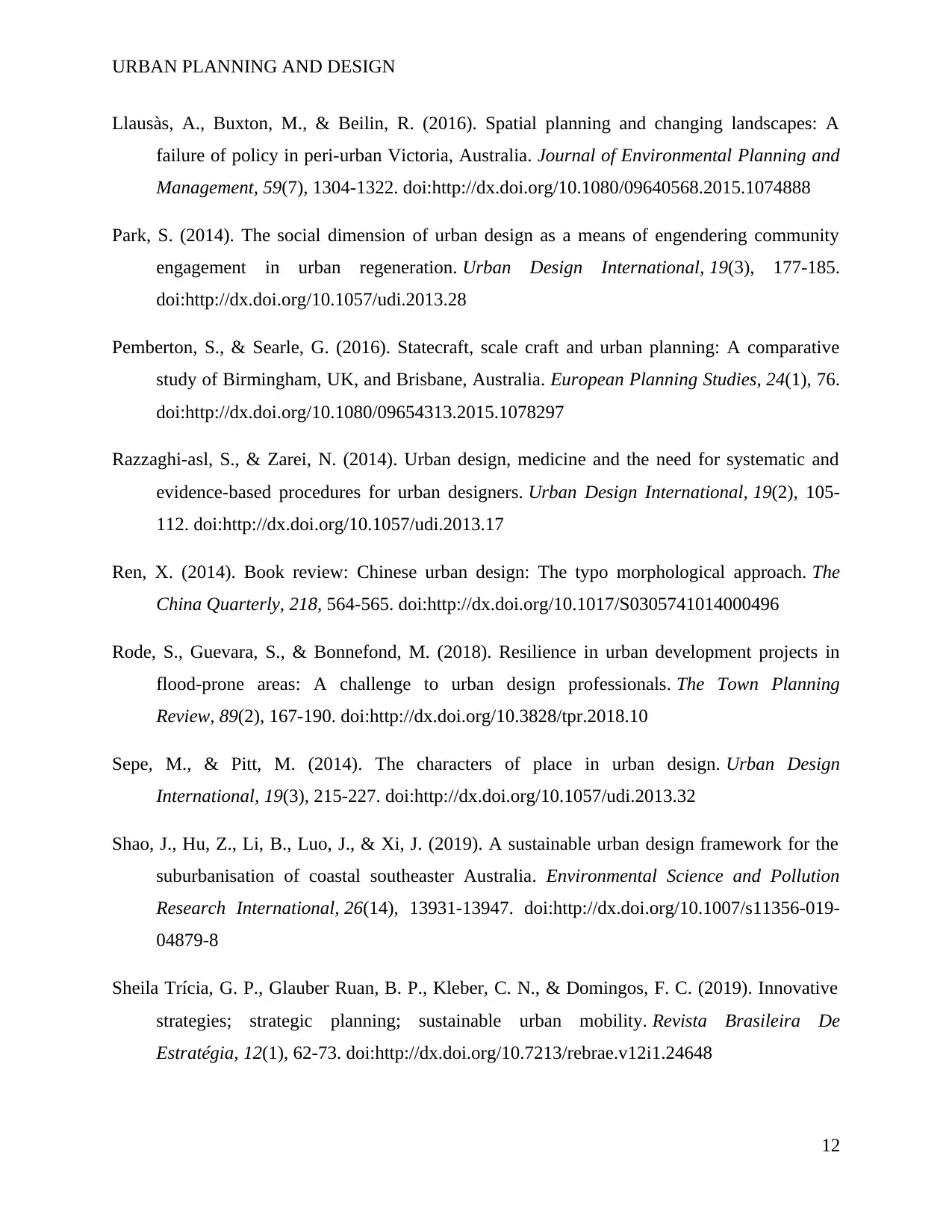
URBAN PLANNING AND DESIGN
Llausàs, A., Buxton, M., & Beilin, R. (2016). Spatial planning and changing landscapes: A
failure of policy in peri-urban Victoria, Australia. Journal of Environmental Planning and
Management, 59(7), 1304-1322. doi:http://dx.doi.org/10.1080/09640568.2015.1074888
Park, S. (2014). The social dimension of urban design as a means of engendering community
engagement in urban regeneration. Urban Design International, 19(3), 177-185.
doi:http://dx.doi.org/10.1057/udi.2013.28
Pemberton, S., & Searle, G. (2016). Statecraft, scale craft and urban planning: A comparative
study of Birmingham, UK, and Brisbane, Australia. European Planning Studies, 24(1), 76.
doi:http://dx.doi.org/10.1080/09654313.2015.1078297
Razzaghi-asl, S., & Zarei, N. (2014). Urban design, medicine and the need for systematic and
evidence-based procedures for urban designers. Urban Design International, 19(2), 105-
112. doi:http://dx.doi.org/10.1057/udi.2013.17
Ren, X. (2014). Book review: Chinese urban design: The typo morphological approach. The
China Quarterly, 218, 564-565. doi:http://dx.doi.org/10.1017/S0305741014000496
Rode, S., Guevara, S., & Bonnefond, M. (2018). Resilience in urban development projects in
flood-prone areas: A challenge to urban design professionals. The Town Planning
Review, 89(2), 167-190. doi:http://dx.doi.org/10.3828/tpr.2018.10
Sepe, M., & Pitt, M. (2014). The characters of place in urban design. Urban Design
International, 19(3), 215-227. doi:http://dx.doi.org/10.1057/udi.2013.32
Shao, J., Hu, Z., Li, B., Luo, J., & Xi, J. (2019). A sustainable urban design framework for the
suburbanisation of coastal southeaster Australia. Environmental Science and Pollution
Research International, 26(14), 13931-13947. doi:http://dx.doi.org/10.1007/s11356-019-
04879-8
Sheila Trícia, G. P., Glauber Ruan, B. P., Kleber, C. N., & Domingos, F. C. (2019). Innovative
strategies; strategic planning; sustainable urban mobility. Revista Brasileira De
Estratégia, 12(1), 62-73. doi:http://dx.doi.org/10.7213/rebrae.v12i1.24648
12
Llausàs, A., Buxton, M., & Beilin, R. (2016). Spatial planning and changing landscapes: A
failure of policy in peri-urban Victoria, Australia. Journal of Environmental Planning and
Management, 59(7), 1304-1322. doi:http://dx.doi.org/10.1080/09640568.2015.1074888
Park, S. (2014). The social dimension of urban design as a means of engendering community
engagement in urban regeneration. Urban Design International, 19(3), 177-185.
doi:http://dx.doi.org/10.1057/udi.2013.28
Pemberton, S., & Searle, G. (2016). Statecraft, scale craft and urban planning: A comparative
study of Birmingham, UK, and Brisbane, Australia. European Planning Studies, 24(1), 76.
doi:http://dx.doi.org/10.1080/09654313.2015.1078297
Razzaghi-asl, S., & Zarei, N. (2014). Urban design, medicine and the need for systematic and
evidence-based procedures for urban designers. Urban Design International, 19(2), 105-
112. doi:http://dx.doi.org/10.1057/udi.2013.17
Ren, X. (2014). Book review: Chinese urban design: The typo morphological approach. The
China Quarterly, 218, 564-565. doi:http://dx.doi.org/10.1017/S0305741014000496
Rode, S., Guevara, S., & Bonnefond, M. (2018). Resilience in urban development projects in
flood-prone areas: A challenge to urban design professionals. The Town Planning
Review, 89(2), 167-190. doi:http://dx.doi.org/10.3828/tpr.2018.10
Sepe, M., & Pitt, M. (2014). The characters of place in urban design. Urban Design
International, 19(3), 215-227. doi:http://dx.doi.org/10.1057/udi.2013.32
Shao, J., Hu, Z., Li, B., Luo, J., & Xi, J. (2019). A sustainable urban design framework for the
suburbanisation of coastal southeaster Australia. Environmental Science and Pollution
Research International, 26(14), 13931-13947. doi:http://dx.doi.org/10.1007/s11356-019-
04879-8
Sheila Trícia, G. P., Glauber Ruan, B. P., Kleber, C. N., & Domingos, F. C. (2019). Innovative
strategies; strategic planning; sustainable urban mobility. Revista Brasileira De
Estratégia, 12(1), 62-73. doi:http://dx.doi.org/10.7213/rebrae.v12i1.24648
12
⊘ This is a preview!⊘
Do you want full access?
Subscribe today to unlock all pages.

Trusted by 1+ million students worldwide
1 out of 13
Related Documents
Your All-in-One AI-Powered Toolkit for Academic Success.
+13062052269
info@desklib.com
Available 24*7 on WhatsApp / Email
![[object Object]](/_next/static/media/star-bottom.7253800d.svg)
Unlock your academic potential
Copyright © 2020–2025 A2Z Services. All Rights Reserved. Developed and managed by ZUCOL.




